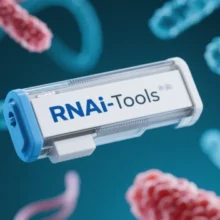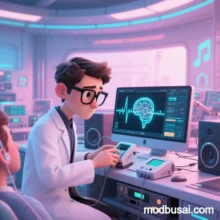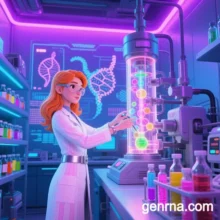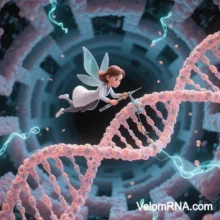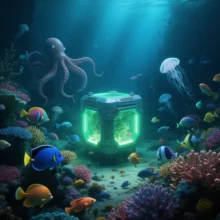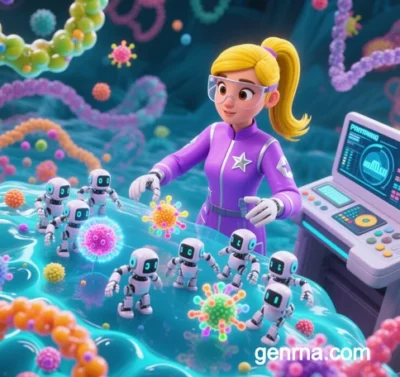
Key Molecules in Gene Expression: mRNA, tRNA, and rRNA
Gene expression is the process by which genetic information flows from DNA to proteins, involving the coordinated action of multiple molecules. Below are the core molecules and their fundamental roles:
1. mRNA (Messenger RNA)
Functions:
- Carrier of Genetic Information: Transfers genetic instructions from DNA in the nucleus to ribosomes in the cytoplasm, serving as a template for protein synthesis.
- Translation Guidance: Uses codons (three-nucleotide sequences) to determine the order of amino acids in a protein.
Structural Features:
- Single-stranded, synthesized via DNA transcription, and complementary to the gene sequence.
- 5′ Cap: A protective structure at the 5′ end that aids ribosome recognition.
- Poly-A Tail: A polyadenylated sequence at the 3′ end that enhances mRNA stability.
- Exons and Introns: Pre-mRNA undergoes splicing to remove introns and retain exons, forming mature mRNA.
Example:
- DNA sequence is transcribed into mRNA as (T in DNA becomes U in RNA).
ATG CGTAUG CGC
2. tRNA (Transfer RNA)
Functions:
- Amino Acid Transporter: Delivers specific amino acids to ribosomes during protein synthesis.
- mRNA Decoder: Uses anticodons to pair with mRNA codons, ensuring accurate amino acid assembly.
Structural Features:
- Cloverleaf-shaped secondary structure, composed of 70–90 nucleotides.
- Amino Acid Attachment Site: Binds amino acids at the 3′ end via aminoacyl-tRNA synthetase catalysis.
- Anticodon Loop: Contains three nucleotides complementary to mRNA codons (e.g., anticodon pairs with mRNA codon ).
CGCGCG
Example:
- A tRNA with anticodon pairs with mRNA codon , carrying the amino acid methionine (Met).
UACAUG
3. rRNA (Ribosomal RNA)
Functions:
- Core Component of Ribosomes: Combines with proteins to form ribosomes, the “factories” for protein synthesis.
- Catalyzes Peptide Bonds: rRNA in the large subunit (e.g., 28S rRNA) acts as a ribozyme, directly forming peptide bonds between amino acids.
Structural Features:
- Constitutes over 80% of cellular RNA, forming ribosomal subunits with proteins.
- Eukaryotic Types: 18S rRNA (small subunit), 28S/5.8S/5S rRNA (large subunit).
- Synthesized from rDNA in the nucleolus.
Ribosome Workflow:
- Small Subunit: Binds mRNA and recognizes the start codon (e.g., AUG).
- Large Subunit: Provides catalytic sites for tRNA binding and peptide bond formation.
- Elongation: The ribosome moves along mRNA (5’→3′), extending the polypeptide chain.
Collaboration of RNA Molecules
- Transcription:
DNA is transcribed into mRNA in the nucleus, which is processed and exported to the cytoplasm. - Translation:
- Initiation: The ribosome small subunit binds the start codon (AUG), and methionine-tRNA pairs via its anticodon.
- Elongation: tRNAs sequentially deliver amino acids, linked into a polypeptide chain.
- Termination: Stop codons (UAA, UAG, UGA) trigger release factors to dissociate the ribosome, completing protein synthesis.
Summary
| Molecule | Core Role | Structural Features | Key Function |
|---|---|---|---|
| mRNA | Genetic template | Single-stranded with codons | Transmits DNA instructions |
| tRNA | Amino acid carrier | Cloverleaf shape with anticodon | Decodes mRNA and transports amino acids |
| rRNA | Ribosome scaffold & catalyst | Forms ribosomal subunits with proteins | Provides synthesis site, catalyzes peptide bonds |
Additional Notes:
- Other RNA Types: miRNA (gene regulation), snRNA (splicing), etc., also assist in gene expression.
- Central Dogma: DNA → RNA → protein, with these three RNAs as central executors.
Through their precise collaboration, cells convert genetic information into functional proteins, sustaining life processes.
Data sourced from public references. For collaborations or domain inquiries, contact: chuanchuan810@gmail.com.
